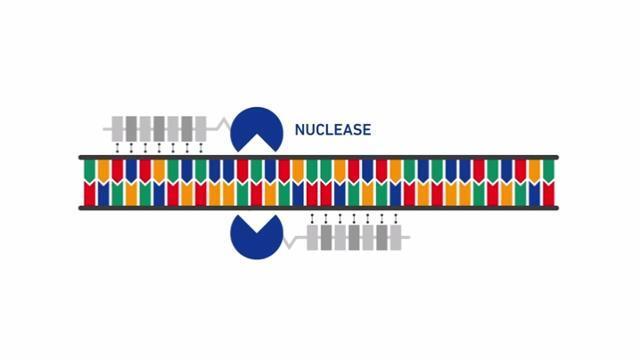Search Thermo Fisher Scientific
TALEN Technology Information
TALENs, or transcription activator-like effector nucleases, are a type of engineered nuclease that can be used for precise and effective genome editing in live cells. This genome editing technology is known to function in a variety of host systems, including bacteria, yeast, plants, insects, zebrafish, and mammals. We've put together a collected of resources that we hope will give you the confidence to get started and to continuously improve research using TALENs.
What are TALENs?
Transcription activator-like (TAL) effector proteins are produced by bacteria in the genus Xanthomonas, which are widely distributed plant pathogens. Natural TAL bind to specific sequences of host DNA, altering the infected plant’s gene expression in ways that further the disease process. The natural TAL effector proteins have two distinct domains: an effector domain and an extraordinarily specific DNA-binding domain.
The structure of the DNA-binding domain can be manipulated to produce a protein domain that binds specifically to any DNA sequence in the genome. These specifically modified DNA-binding protein domains can then be linked to a custom effector domain (e.g., a nuclease, or a transcription activator or repressor) to create a chimeric protein capable of precisely targeted DNA manipulation.
Whether through targeted nucleases for genome engineering, or by precisely directed moderators of gene expression, researcher-designed TALEN effector proteins are already helping advance a broad range of life science applications, including cell, molecular, and synthetic biology; drug discovery; and biofuels research.
How does TALEN work?
Derived from Xanthomonas TAL effectors, the DNA-binding domain of TALs consists of a variable number of amino acid repeats. Each repeat contains 33–35 amino acids and recognizes a single DNA base pair. The DNA recognition occurs via two hypervariable amino acid residues at positions 12 and 13 within each repeat, called repeat-variable di-residues (RVDs), as shown in Figure 1.
TAL effector repeats can be assembled modularly, varying the RVDs to create a TAL protein that recognizes a specific target DNA sequence. Linking the repeats is straightforward, and long TAL effectors can be designed to specifically target any locus in the genome.

Figure 1. TAL effector DNA-binding domain. The DNA-binding domain structure can be manipulated to produce a protein domain that binds specifically to any DNA sequence in the genome.
Double-stranded DNA breaks can be created at your specified genomic locus by using a pair of GeneArt TAL proteins that have been fused to the Fok1 nuclease (Figure 2). Using a pair of TAL proteins for the targeting reduces off-target effects.
Figure 2. Designing target sites for customized TAL effectors for maximal binding. (A) TALs encode a DNA-binding protein specific to a customer-submitted sequence, fused to a FokI nuclease domain for genome editing. The sequence targeted by our first-generation TAL effectors must have a T at its 5’ end and spacing between forward and reverse TAL effectors must be 13–18 bp for proper pairing of the FokI nucleases and creation of the double-strand break. (B) We have further engineered TALs to eliminate the 5'T constraint of the DNA binding domain, which allows targeting of any sequence across the genome; 15–16 bp spacing between the two TAL effectors is optimal.
The breaks induced by the Fok1 nuclease domain are subsequently repaired through either of two endogenous cellular mechanisms: nonhomologous end joining (NHEJ), or homology-directed repair (HDR).
- NHEJ is prone to errors and often introduces a frameshift mutation when it occurs within the coding sequence of a protein-coding gene, effectively silencing the gene
- In HDR, homologous DNA “donor sequences” can be used to introduce a defined new DNA sequence
Consequently, a protein fused to a Fok1 endonuclease can be used to induce gene silencing or to accurately insert an engineered DNA fragment into an exact location in the genome.
Learn more about TALEN technology

Application Note: Using Sanger sequencing to facilitate CRISPR- and TALEN-mediated genome editing workflows
Learn how Sanger sequencing by capillary electrophoresis and Minor Variant Finder Software can be used in a genome editing workflow. We show the results of CRISPR-mediated editing, but the principles applied here can also be used for ZFN- or TALEN-mediated editing workflows. The simplicity and cost-effectiveness of the workflow and uncomplicated data analysis make Sanger sequencing by capillary electrophoresis a valuable part of any genome editing workflow.

Blog: Straight From The Scientist—Jon Chesnut on CRISPR versus TALEN
CRISPR and TALEN tools and technologies are changing the way we do gene editing today and in the future, but what are the differences between these two? And when would you use one technology over the other? This article addresses these questions and more.

Genome Editing Resource Library
Access a targeted collection of scientific application notes, publications, videos, webinars, and scientific posters for genome editing.

Genome Editing Resource Guide
Intended as an introduction to genome editing, the resource guide covers the technologies available today for gene editing, along with methods for design, delivery, and detection of edited cells.
Additional resources and support for TALEN technology
For Research Use Only. Not for use in diagnostic procedures.

